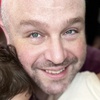2008/04/27
New York Society for Ethical Culture
André-Michel Schub, piano
Cho-Liang Lin, violin
Paul Neubauer, viola
Gary Hoffman, cello
I arrived at the New York Society for Ethical Culture an hour before the concert, eager to hear a scheduled chat between Joan Tower and Bruce Adolphe. The latter is a musical educator and polymath whose Piano Puzzlers (formerly hosted by NPR, now on American Public Media) challenge listeners to identify popular tunes embedded in the keyboard styles of famous composers; the former is the composer of three works appearing on the program that evening, two of which were receiving premieres. Lacking familiarity with Tower and her works, I was hoping to gain some insight by hearing her discuss her music in her own words. It was not to be. By way of explanation, presenter Wu Han volunteered that the composer was unable to attend the concert, as she had fallen earlier in the day and “broke her both knees.”
At the time, the audience gasped. At a few days' remove, it has since struck this listener as darkly humorous that the titles of the first two Tower works — “Simply Purple” and “Wild Purple” — could describe bruises in various states of repair. And purple was the first thing I noticed about the performance space: under the arch behind center stage the wall was painted purple, and at the back of the mezzanine were purple curtains to block light from the street. The Society for Ethical Culture is not a typical venue for events under the imprimatur of Lincoln Center, which is short on performance space as it undergoes various construction projects, but even in the absence of color coordination it would have worked. Compared with Alice Tully Hall the space is more intimately arranged, a study in half-circles rather than straight lines, and the low stage puts the music at eye and ear level. For solo and chamber works, it fits.
The Beethoven Variations in E flat major, Op. 44 (for piano, violin, and cello) were — at least on the Beethoven-o-meter — something of a trifle. On a small scale and in a fairly classical style, the piece sounded like a warm-up for the composer as much as for the instrumentalists. Named for Tower's association of the color with the sound of the instrument, the two Purples for viola followed. Played first, written this year, “Simply Purple” opened with a halting, plaintive rising scale, mostly by half steps. Melodic intervals of minor thirds and major thirds alternated, all arco and impassioned. After a pause for trilled harmonics, violist Paul Neubauer returned to full bowings, climbing piecemeal as in the opening, fading wispily to a close in a high register. “Wild Purple,” a 1998 work also written expressly for Neubauer, started in a similar blue vein of half-steps but quickly turned far more virtuosic, filled with arrays of discontiguous double-stops of thirds, tritones, minor seconds, bowing madly and dashing down and up the fingerboard for some excitable moments. Neubauer attained a very breathy, woody sound at times. Purple, perhaps? I might concede the point.
Despite the copious double stops of the earlier work, Tower's solo viola pieces mostly suggested harmonies rather than explicitly outlining them. So it was instructive to one in search of her musical language to hear her “Trio Cavany” for piano, violin, and cello. With harmonies trading in tritones, sevenths, and ninths, its rhetorical fire and imitative motion belied a lack of dynamism. Rhythmically there was rarely anything to get attached to, and like the shapes of the performance space, the music doubled back on itself, never moving far from its starting point.
At a climactic silence, a program fluttered from a gentleman's lap into the aisle two rows ahead. I couldn't see his face, but I could guess its color.
